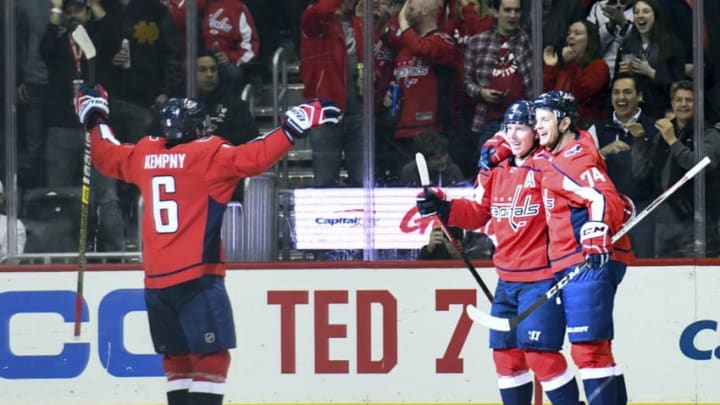There’s a very real and legitimate argument that the Washington Capitals most crippling blow to their repeat chances came before the playoffs even began.
On March 20, Washington Capitals defenseman Michal Kempny tore his left hamstring against the Tampa Bay Lightning and was announced out for the season.
Brought in last year near the trade deadline, Kempny stabilized the Capitals defensive corps and gave John Carlson a bonafide left-handed shot to play with on the blue line.
Carlson, and Kempny, became a sturdy top-pair and helped the Capitals win the Stanley Cup last season. For his contributions, he signed a four-year, 10 million dollar contract to stay in Washington. He credited coach Todd Reirden with potentially saving his teetering career in the NHL.
More from Capitals News
- Breaking down the Rookie Camp roster
- Hear what Magic Johnson said about Alex Ovechkin
- Capitals announce Rookie Camp schedule
- Breaking down the 2023-24 Capitals national TV schedule
- Capitals Alumni Weekend is coming back
But after about a month of elite play from the Capitals, which saw their Corsi For Percentage raise to 57.44 at five-on-five play, Kempny’s injury had a tangible effect on the blue line and the rest of the team.
The possession metrics strongly favored Washington from the deadline to March 20, but from March 21 to the end of the regular season, the Capitals possession statistics plummeted. For the final three weeks of the regular season, they owned just 47.61 percent (nearly a 10 percent fall), a steep enough drop to place them 21st in the league in that time frame.
While it’s not responsible to credit Kempny’s injury as the lone, or even main, factor, it certainly had a noticeable effect on the team’s play.
The rest of the regular season was a defensive game of musical chairs, with no pairing feeling just right for Carlson, or the third pairing with Brooks Orpik. The second pairing of Matt Niskanen and Dmitry Orlov saw increased minutes, but with their struggles not going away, that only further plagued the team.
Most of the team was dominating possession before Kempny’s injury; Carlson and Kempny ranked fifth and seventh on the team with percentages of 62.42 and 59.82. With the top-pairing rolling, Niskanen and Orlov were eighth and ninth with percentages just a shade under and over 59, respectively.
The third pairing of Orpik and Nick Jensen was able to tread water at around 50 percent, which is all that could be reasonably asked of that pairing.
Essentially, the Capitals had a flowing dichotomy of defensive pairings, and they all were dominant against the opposition. Then, Kempny’s injury happened.
Carlson, given the task of having seemingly a new defensive partner each night, saw his Corsi percentage plummet to 46.94. Orlov was able to hit 50 percent on the nose, but Niskanen fell to below 50 percent against tougher minutes than he saw before.
So while it might have seemed that Kempny was one of the interchangeable pieces on the roster, his absence proved just how much he meant to the team.
The Capitals have the skill to overcome a loss in the forward ranks (see, T.J. Oshie) but a loss to a top defenseman on the team proved too costly.
Julia Karron of Russian Machine Never Breaks illustrated the 2-1-2 forecheck the Hurricanes employed against the Capitals in the first round series, and it’s not hard to see where Kempny’s impact could’ve had a demonstrable effect on the series.
Carolina is a team that will own possession, and one of the ways they do that is by constantly shooting the puck at the net. For some teams, that means a loss of possession and an almost meaningless shot. But Carolina’s pressure in the other team’s defensive end is multi-faceted: It keeps teams on the defensive and unable to score goals (see; New York Islanders) and it causes turnovers in the offensive end (see; Washington Capitals).
Jonas Siegenthaler did an admirable job filling the role of Christian Djoos in the series, but one can’t help but wonder the kind of steadying presence that Kempny would’ve had in breaking the puck out and sending the Capitals on the offensive.
It wouldn’t be hard to see the Capitals puck bounce the other way in what amounted to a coin-flip series.
The Capitals won’t be without Kempny for long next year, as the recovery time is expected to be four-to-six months. Assuming his surgery, which was announced on April 2, took place at the end of March, it’s safe to put the timeline for a return as early August to early October. Meaning, there’s a good chance he’ll be in uniform for opening night.
He’ll be needed, as there’s a chance that the Capitals defense looks a bit different next season. Then, though, there shouldn’t be any second thoughts about how much Kempny means to the organization.
